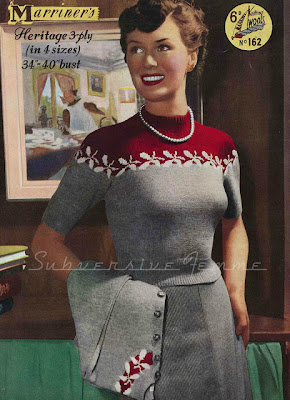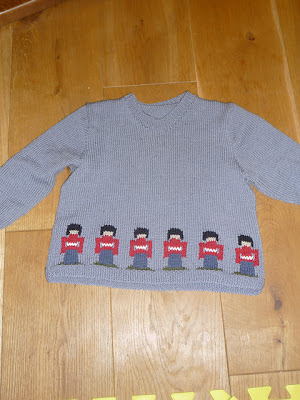This is the eighth post in my series on 20th century knitting patterns (you can see all the other posts in the series here), and it offers a selection of knitting patterns from the years from 1970 to 1979. And I must say researching this post gave me some fleeting yet intense moments of wanting to throw myself under a Donna Summers tour bus. I won't even blame the general seventies aesthetic. Yes, there are plenty of examples of horrible seventies attire and bad hair out there, but you can say that of any decade. All the patterns for this series were cherry-picked. Every set of ten patterns I have selected for this series because they were wearable and attractive by modern standards was the result of several hours spent sifting through a hundred or more patterns that weren't. On the whole, I find more to admire about seventies fashion than those of the sixties. The clothes available for every day (as opposed to disco wear) had neither the prim constraint of the early sixties nor the psychedelic extremes of the sixties but instead achieved a happy medium of relaxed, flattering, wearable style.
I think there are two factors that made my seventies pattern research slightly scarring. The first one is that the materials available in the seventies were generally ghastly — horrible stiff, scratchy, synthetic fibres in awful colours — and garments can only be as good as the materials from which they are made. The shapes of seventies clothing were generally good, and if I re-imagine seventies designs in modern fibres and colours they suddenly look very desirable indeed. It was the fabric used that made the leisure suit such a byword in tackiness, not the basic style of it. The second contributing factor is that the seventies were a bad time for crafting. Needlework is of course traditionally the province of women, and given there were many more women in the workforce in the seventies than there had been for decades, women simply had less time for such things. The crafting industry inexplicably responded by dumbing down crafting kits to make them more desirable, and again, the fibres and colours available in the seventies were wretched, so the result was not pretty. So while the clothing design of the seventies wasn't too bad (save and except for a few bad styles such as the hot pants above), the home décor and accessory patterns were often really freaking terrible. I saw patterns for matching toilet seat and toilet roll covers, for lampshades described as "Tiffany-style" that probably had Louis Comfort Tiffany rolling in his grave, for pointless and retina-burning mobiles, for driving gloves and steering wheel cover sets (why?!?), and for some truly frightening dolls and toys.
All that said, I did find a pretty good set of clothing patterns, and I hope you like them. Unfortunately although I do my best to include at least one menswear, one child's, and one home décor pattern in each post of this series, these seventies-era patterns are almost all women's patterns because I just couldn't find anything I liked for any of those categories. But look on the bright side... I have not included a link to the hot pants set pattern above. You're welcome.
When I began to work on this post, I thought I should try to find a poncho pattern for it, because they were so archetypically seventies. It didn't happen because I dislike ponchos and didn't find any that gave me any reason to change my mind on that point. However, seventies designers also seemed to favour knitted coats. This duffle jacket pattern originally appeared in The Australian Women's Weekly in June of 1972 and is available as a free pattern. If I were making this jacket, I'd probably replace the toggle fastenings with something else, though smaller toggles would probably look current enough.


This halter top pattern originally appeared in Mon Tricot Fashion Edition's Spring/Summer 1973 issue. There actually isn't a pattern available for this piece, but who needs one when this pattern is simply two tube scarves knitted long enough to fit around the wearer and then sewn together? I adore the colours of the contemporary version of this design.
This open front jacket design originally appeared in The Australian Women's Weekly in March of 1974, and is a free pattern.
I love all the clever detail in this turtleneck pullover, and think it would look pretty amazing done in a solid colour with a handpainted yarn as the contrast colour. This pattern appeared in The Australian Women's Weekly, in February 1977 and is a free pattern.
This hooded jacket appeared in The Australian Women's Weekly in February 1977, and is a free pattern. To update it for modern wear, I'd raise the dropped shoulders, consider another kind of fastenings than the toggles, and ditch the blanket stitch, especially at the top of the sleeve, because it makes the coat look like something from the Bride of Frankenstein's trousseau. Instead I'd finish the garment with a picot edging, which could always be done in a contrast colour if desired.
One of the things that has really struck me as I have worked through this series of posts was that baby knits have consistently remained very traditional. Every decade produced remarkably similar-looking lacy baby blankets, and lacy, ribbon-trimmed bonnet, bootee and sweater sets, and they are still commonly available patterns today. I expected something different from the progressive seventies, yet they had embroidered bunting bags and ribbon-trimmed surplice baby sweaters as well. This baby jacket, which originally appeared in Needlework and Craft in Spring 1979, looks as though it could have been created at any time in the previous five or following three decades. This pattern is available for free.
This is the Rorschach Sweater, designed by Elizabeth Zimmerman. It appeared in Needlecraft for Today in November/December 1979 and is available as a $1 download. The pattern includes directions for knitting the sleeves cuffed or belled, and it's possible to go with one tab or none at all, and to omit the belt.
The sporty-looking stripe is so common in seventies fashions, probably because there was such a upswing of interest in physical fitness. This top rather looks as though it were made to go with striped-top sweat socks pulled nearly to the knees, but I think it would look much less so if the colours were updated. The pattern is available from the Vintage Knitting Lady for £2.00, or you can get a PDF for £1.50.
Quite like these little tie-top tanks. The pattern is available from the Vintage Knitting Lady for £2.00, or you can get a PDF for £1.50.
This style of hat is so very seventies and yet would still look right today. The pattern is available from the Vintage Knitting Lady for £2.00, or you can get a photocopy for £1.99 or a PDF for £1.50.




















































